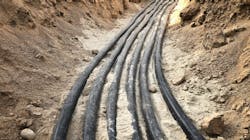Utilities Evaluate the Full Costs and Benefits of Undergrounding Distribution
Widespread outages from recent natural disasters -- hurricanes, heatwaves, wildfires, wind, and ice storms -- have the attention of utilities, regulators, legislators, and customers alike. They want solutions.
Early in my career, I worked for a state PUC and spent many long nights at public hearings related to utility storm response investigations. I fondly remember a customer referring to the area they lived as the “the land of trees.” He, along with many other customers, recommended that the utility bury all their facilities. At this point in the hearings, the utilities would generally respond with the astronomical cost to underground all lines. Not much would change and, we would all repeat this same grueling process during the next storm season- widespread outages, high storm restoration costs, outraged customers, and equally enraged politicians. However, this dichotomous approach to undergrounding need not be the case.
Electric utilities can accomplish grid resilience in different ways, but most efforts are focused on either a plan to harden the overhead system or place facilities underground. As previously alluded, from a cost and logistical perspective, it is not always feasible to underground all facilities. However, a potentially cost-effective approach is to select lines to be placed underground based on specific design requirements and perceived societal benefits. As part of the solution, electric utilities have implemented strategic underground programs to help optimize the resilience of their distribution systems.
Strategic undergrounding is a data-driven approach that identifies critical overhead distribution feeders, equipment, and lines as candidates for proactive undergrounding. A strategic undergrounding program helps identify the lines most prone to outages and considers undergrounding to improve grid resilience and the total time of restoration of overhead distribution lines.
Our industry needs to evaluate the lifecycle cost of distribution line assets. Utilities are now getting excellent and current initial price, performance, and O&M data. Utilities like Dominion, Florida Power & Light, Georgia Power, Pepco, and others are starting to analyze the results with this new data.
Pepco’s District of Columbia Power Line Undergrounding (DC PLUG) initiative is a US$500 million project jointly funded by Pepco and the District. It focuses on the underground placement of up to 30 of the most vulnerable power distribution lines. In the face of increasingly severe storms, the DC PLUG initiative expects to improve resilience and to improve reliability on selected feeders by an estimated 95%.
San Diego Gas & Electric is also working on expanding the underground electric infrastructure in the town of Julian in San Diego County, California, as part of its ongoing effort to reduce wildfire risk and the impact of Public Safety Power Shutoffs (PSPS) during extreme weather conditions. For SDG&E, the strategic undergrounding of overhead power lines is one element of a multi-pronged approach to reducing wildfire risk.
Dominion Energy has been studying the effectiveness of its undergrounding efforts for well over a decade. In addition to SAIDI-based reliability programs, the utility also focuses on Total Length of Restoration (TLR) to improve overall reliability. Dominion’s data analysis indicated the need to focus on distribution tap lines to improve TLR. For Dominion, tap lines made up 50% of its total overhead distribution line mileage, and 60% percent of its tap line outages occurred on 20% of the tap line mileage. They then understood that the target was to concentrate on undergrounding that 20%, where possible.
Karen Kinslow, director of Grid Resiliency at Dominion Energy, told T&D World, “The first thing everyone thinks about is the cost of undergrounding. And while upfront costs are significantly more expensive, we began by strategically targeting the most outage-prone lines. Our analysis showed we could eliminate up to 50% of recovery time after a severe weather event just by putting 20% of our tap lines underground. We’re only about a third of the way done, but already we’re seeing time off our major events. Other utilities have reached out and asked about our experience with undergrounding. They may tackle it a different way, but my advice is to analyze the data and focus on areas with the highest risk.”
Another critical point Karen emphasizes is that undergrounding just a portion of Dominion’s overhead lines provides value to all customers, not only those directly placed underground because it reduces work when the utility responds to a severe weather event. Dominion Energy’s 10-year Strategic Underground Program® has reduced the repair or recovery time after large storm events by 40-50%. Our next issue of T&D World, in December, will also feature an in-depth case study about Dominion’s strategic undergrounding program.
Additionally, T&D World also recently hosted a webinar about Strategic Undergrounding on October 13th, where Dominion Energy shared seven years of “lessons learned” and project success with strategic undergrounding. Karen also discussed customer satisfaction and communication, project selection, implementation, and measuring results. You can register for this free webinar at https://www.tdworld.com/resources/webinars/webinar/21140194/webinar-strategic-undergrounding-dominions-lessons-learned.
Strategic undergrounding is an excellent opportunity for utilities to build a more reliable and resilient system, improve the aesthetics of communities, and add shareholder value as we move into 2021 and beyond.
Until next time, stay safe!
About the Author
Martha Davis
Senior Director of Content
Prior to working at T&D World and Utility Analytics Institute, Martha worked as an executive in the energy industry for about 15 years. She has held various regulatory and government affairs positions and had the opportunity to shape public policy.
Martha has a B.A. from Westminster College in Fulton, MO; completed specialized legal and public policy coursework at American University in Washington, D.C.; M.P.A. Public Affairs and M.B.A. Business Administration both from the University of Missouri. She is currently a doctoral candidate at the University of Denver where she is researching business analytics, innovation and regulation.
